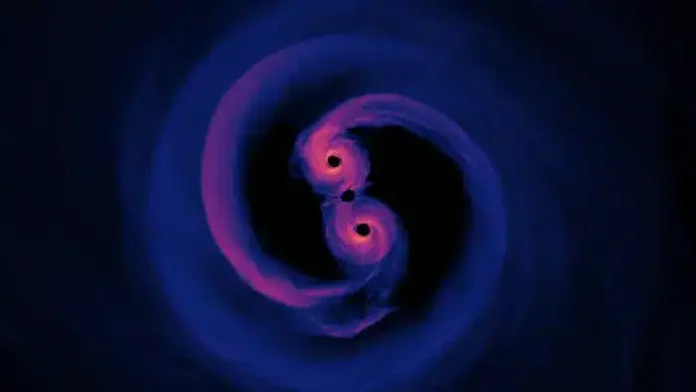
On one end, we have gigantic supermassive black holes, and on the other, tiny particles of dark matter. These two seemingly disparate cosmic features have been found to share a surprising connection, potentially solving a long-standing problem in astronomy.
The Beginning: Gravitational Wave Hum
It all began in 2023 with the discovery of a hum of gravitational waves in space. Gravitational waves are ripples in the curvature of spacetime, first confirmed in 2015. This pervasive background signal is thought to originate from millions of merging pairs of supermassive black holes. To give you an idea: each supermassive black hole is billions of times heavier than our sun.
The Final Parsec Problem
The issue with this theory is that simulations showed when pairs of these colossal black holes spiral towards each other, their approach halts abruptly at a distance of one parsec. A parsec is over three light-years. This stall prevents the merger from occurring, a dilemma known as the ‘final parsec problem.’ All theories and observations run into trouble because of this final parsec.
This quandary not only conflicts with the theory that merging supermassive black holes are the source of the background gravitational wave noise, but it also contradicts the notion that supermassive black holes grow over time by merging with smaller black holes.
The Role of Dark Matter
So, how can this issue be resolved? Enter dark matter. Supermassive black holes can bridge this final parsec and merge thanks to a previously overlooked property of dark matter particles.
Supermassive black holes are believed to reside in the centers of most galaxies. When two galaxies collide, their black holes enter orbit around each other. As they orbit, the gravitational pull of nearby stars causes them to slow down, nudging them closer to merging.
A Path to Merger
Previous models showed that as supermassive black holes approach within a parsec, they start interacting with the surrounding dark matter cloud. The gravity of the orbiting supermassive black holes ejects dark matter particles from the system. The resulting scarcity of dark matter means no energy is extracted from the black hole pair, stopping their inward spirals. Hence, they remain a parsec apart, unable to merge.
However, it appears astronomers missed something. In a new model, researchers showed that dark matter particles interact with each other in such a way that they aren’t scattered, keeping the density of the dark matter halo high enough. This ongoing interaction with the black holes allows their orbits to continue shrinking until they indeed merge.
“The possibility that dark matter particles interact with each other is an assumption we made, an additional ingredient that not all dark matter models have,” says researcher Gonzalo Alonso-Álvarez of McGill University. “Our argument is that only models with that ingredient can solve the final parsec problem.”
Insights into Dark Matter
Besides shedding light on black hole mergers and the background gravitational wave signal, the new result offers insights into the nature of dark matter. “Our work provides a new way to help us better understand the particles that make up dark matter,” Alonso-Álvarez notes. “We discovered that the orbital path of black holes is highly sensitive to dark matter. This means we can use observations of mergers to gain more insight into these particles.”
Researchers found that the interaction between dark matter particles suggested in their model could also explain the shape of much larger galactic halos of dark matter. “We now know the final parsec problem can only be solved if dark matter particles interact at a rate that can alter the distribution of dark matter on a galactic scale. This was unexpected because the physical scales at which these processes occur differ by three or more orders of magnitude,” they concluded.











